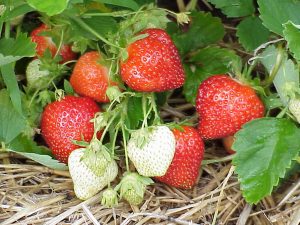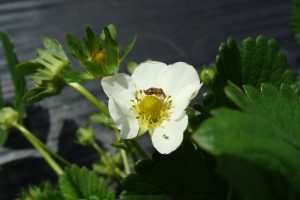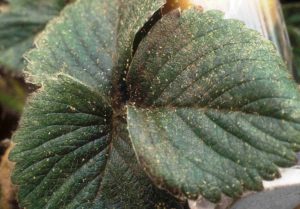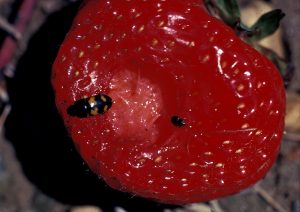Strawberry IPM Newsletter No. 4- June 11, 2021

Strawberry IPM Newsletter No. 4- June 11, 2021
Click on photos to enlarge
HARVEST UNDERWAY IN SOUTHERN MAINE
Early Crop Looks Good for Both Quantity and Quality
Situation:
Hot-dry weather has ripened fruit rapidly in the past week. Fields in Southern Maine have been spot picked for the past few days for stand and market sales, with a few fields likely to open to PYO customers this weekend. This is an early start for the picking season, and hopefully pickers will get the message. You can help by advertising your expected opening date soon, and letting customers know that if they wait they may lose out; a continuation of this hot weather trend could make the season shorter than normal.

Tarnished plant bug activity has been inconsistent from field to field, with some over threshold and nymphs ranging from very small to nearly adult size, and other fields having none. If there is still some late bloom or petal fall stage blossoms in your field, it is susceptible to tarnished plant bug injury. Therefore, they should be scouted regularly and protected if the spray threshold of 4 or more flower clusters infested per 30 sampled is exceeded.

Two-spotted spider mites were found in most fields visited this week, but numbers were well below threshold in spite of the recent warm-dry weather. This maybe, partially due to the presence of predator mites I’ve observed in most fields. At this point, it would be best to wait on spraying for mites until after bed renovation, unless a field is heavily infested.

Sap beetles may become a problem as fruit start to ripen. This pest has been reported in southern New England over the past week. The 1/8 inch long, dark-brown beetles chew small holes in ripening fruit, similar to slug injury. The damage often allows rot organisms, such as Botrytis, to then infect the fruit. The best management strategy for sap beetles is good sanitation. Keep the field free of overripe fruit by picking often and thoroughly. Insecticide sprays for this pest can be effective, but should be a last resort during the harvest period. Assail® Brigade®, Dibrom® and PyGanic® are registered for control of sap beetles with pre-harvest intervals ranging from 12 to 24 hours. Read the product label carefully for this and other application instructions and restrictions.

Diseases:
Fields that have experienced significant rain or have been getting overhead irrigation should be protected against gray mold infections. If it has been more than 14 days since the last fungicide application, or your fields have received more than an inch of rain or overhead irrigation, another fungicide application should be made to protect later opening flowers and developing fruit.
Anthracnose Fruit Rot:
As fruit starts to size up and ripen in fields that are wet from irrigation or rainfall, be on the lookout for anthracnose. This fungus disease is favored by warm, humid conditions and can spread rapidly via splashing water during rain or irrigation events, especially if puddles remain in a field. Anthracnose appears as black sunken lesions on the berries with orange spore masses in them. The fungus can multiply on leaves without visible symptoms, which is why it may appear suddenly and widespread in a field. Recommended fungicides for anthracnose include Pristine®, Cabrio® and Abound®.
Sunscald has been seen on some early ripening fruit, especially where the foliage is sparse and not adequately shading the berries. The injury first appears as a silvery or light brown water-soaked area on the exposed side of the berries. These turn to large brown, sunken dry patches. Sunscald occurs when the fruit is exposed to intense heat and light, especially when this follows cloudy-rainy weather. The ripe fruit absorbs the light, causing the tissue to reach temperatures high enough to kill the cells within, resulting in the damaged areas. Affected fruit are more susceptible to rot organisms such as gray mold. Irrigation on hot- sunny days will cool the plants and reduce susceptibility to sunscald. Good foliage cover over the berries reduces the likelihood of damage.
Annual Pre-Harvest Checklist for Pick-Your-Own
Is your farm ready to provide your customers with the best possible picking experience? This is especially important with the continuing challenges of the coronavirus pandemic. Inform your customers of new guidelines, including social distancing and sanitation protocols, so they know what to expect when they arrive on your farm.
- Your phone message and web/social media pages with picking conditions and opening and closing times should be regularly updated, and provide information about how fields are being managed to protect customers from COVID-19.
- There is easy access to the fields and plenty of parking. If possible, entries and exits should be on opposite sides of the lot to reduce cross traffic and congestion.
- Someone is ready to greet customers and offer parking instructions and directions to the field. Protective face masks or shields should be worn by staff and customers when indoors. Disposable masks should be available for customers.
- Access to the field is free of hazards. Entries and exits should be on opposite sides of the field. All foot traffic should be one way up the rows. Use flags to mark where the last customer stopped picking, and the next should begin, Customers should stay in assigned rows and not allowed to be within 6 feet of other customer groups
- If transportation is provided for the elderly and disabled, follow social distancing as much as possible, e.g. no group transportation, and as much space as possible between riders and drivers.
- The rules regarding picking, distancing, sanitation and traffic flow are clearly posted.
- Someone is in the field to show customers where to pick, explain picking guidelines, and to answer questions.
- Restroom and hand washing facilities are available and regularly cleaned and sanitized. Customers should wash hands before entering the field. Instructions for proper hand washing should be posted
- Fruit and containers should be handled as little as possible. Have shields set up at weigh stations and checkouts between customers and staff. Scales and countertops should be sanitized frequently. Customers should maintain distancing during the checkout process. The entry and exit from the checkout should be one way; no cross traffic.
- No playgrounds, petting zoos, picnic areas, etc. Customers should be discouraged from congregating at the farm, especially indoors.
- The help is friendly and knowledgeable.
The pandemic has forced us to limit the social aspects of the pick-your-own experience, but, by keeping customers informed about your concerns for safety and providing a friendly, clean, efficient and organized atmosphere, you will build trust and good faith with them, encouraging them to return and recommend your farm to their friends.
COVID-19 information for farmers:
For more information regarding growing and marketing crops under COVID-19 restrictions please visit our webpage
Sincerely,
David T. Handley
Vegetable and Small Fruit Specialist
Highmoor Farm Pest Management Unit
P.O. Box 179 17 Godfrey Dr.
Monmouth, ME 04259 Orono, ME 04473
207.933.2100 1.800.287.0279
Where brand names or company names are used, it is for the reader’s information. No endorsement is implied nor is any discrimination intended against products with similar ingredients. Always consult product labels for rates, application instructions and safety precautions. Users of these producers assume all associated risks.
The University of Maine is an equal opportunity/affirmative action institution.
